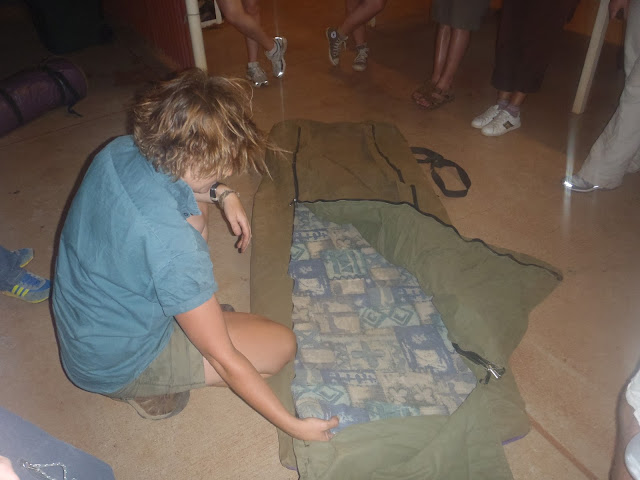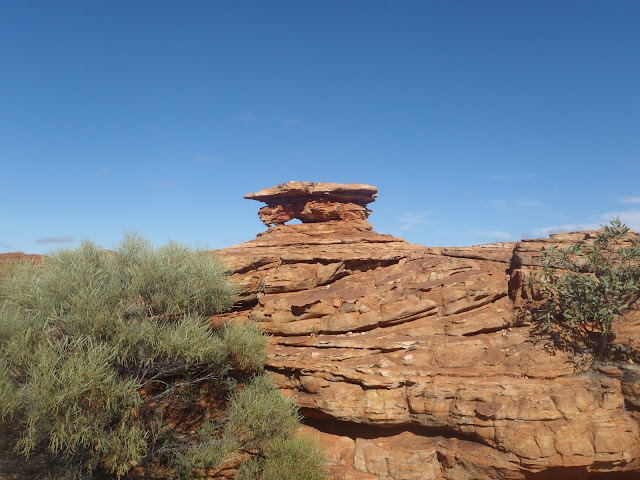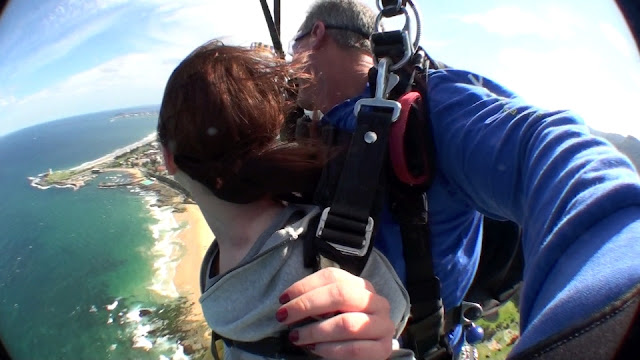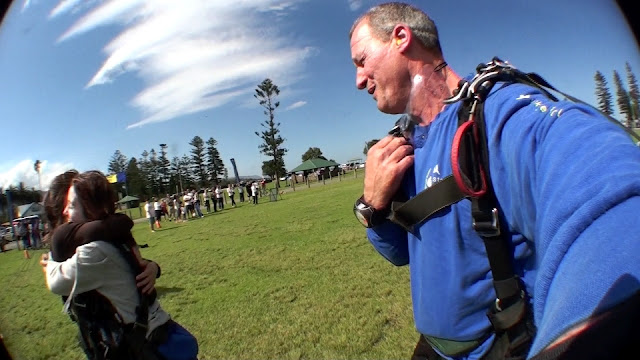Note: I wrote this blog write before my computer crashed and didn't get a chance to post it until now (because I just got it back, duh). This dates back to mid-october.
I have just returned from a trip to the Outback, or the Red Center as it is also called. What a unique, educational experience and rugged three days! I went on The Rock Tour, a three day, two night camping trip and guided tour through 1,500km (932 miles) of the Northern Territory, mainly to Uluru, Kata Tjuta and Kings Canyon. This trip was unlike any other I have ever been on for many reasons: I went by myself (up until this point I had gone on my Australian excursions with either Sara, Aubrey or both), was up at 5:00am each day (eek!), did not shower for 3 days (well I washed my body, but not my hair), slept in a swag on the dirt ground under the stars (or rain, as was more often the case), and had absolutely no access to electronics or technology (that is, computers, internet, facebook, television, etc.). It was a dramatically different way of life compared to living in Sydney, which was precisely why I went.
Day 1: Uluru
Sunday morning I hopped a flight from Sydney to Ayers Rock. (Side note: airport security here is so lax! They didn’t check my I.D., I didn’t have to bag all my liquids, and I could walk through the scanner with my sneakers on. It took a whole one minute to pass security). On the airplane I was seated next to Mr. Erudite-Outback, a gentleman who was hoping to start his own tour company in the outback and therefore new all there is to know about the northern territory. For the entire trip he pointed out land masses below that I must see, instructing me to “Go sit in that front seat up there and look down” or “Go sit in that empty seat in the back and look out.” Of course I always listened, and each time after a few minutes the stewardess would come over and ask me to “please return to your seat.” She had to ask me this three times. I was like the naughty child at school that she couldn’t tame, but I had to see what Mr. Erudite-Outback insisted I see, the coolest of them all being Lake Eyre. Apparently, the last time that Lake Eyre was actually full was in the 1970’s. Usually the outback is so dry that the lake never fills, but this year has been an extremely wet season as a result the lake is full again. This, as Mr. Erudite-Outback explained, is very rare and I had the great fortune (thanks to my chance encounter with him) to see the massive, impressive lake abounding with water. From above it looked like an enormous piece of marble tile swirling with vibrant red, white, grey and blue colors. When full, it is the largest lake in Australia.
Once at Ayers Rock airport, I was picked up by the Rock Tour in a rickety-rackety bus. I felt like I hopped onboard an 80’s hippie-mobile. This was no Greyhound bus. Forget the air conditioner, recliner seats and free Wi-Fi, this sucker was equipped with sleeping bags, dirty back packers and coolers. Oh, and flies, lots and lots of flies. It was jammed pack with about 20 campers in total, all from around the world. We spent the first portion of the trip introducing ourselves. I was one of two Americans on the trip; we were both named Sarah (figures). Our Aussie tour guide was also Sarah. She was one tough chick. I have enormous respect for Sarah and her ability to successfully lead a group of 20 adults through the outback. By the end of this blog you’ll understand what I mean. In addition to the Sarah’s, there were two Italian girls, a Brazilian, a Canadian, a Korean, a French couple, a Norwegian, two Australian sisters and some Swedish peeps. These were my comrades with whom I embarked on a 3 day camping trip through the red center of Australia
 |
| The inside of the Rock Tour bus |
We wasted no time seeing the main attraction: Uluru, as the aboriginals call it, or Ayers Rock, as us white folks call it. I will call it Uluru for this blog. Both names refer to the massive, red rock located smack dab in the middle of no where, as if it just plopped magically onto the earth. It is the world’s largest rock. This rock is
the iconic symbol of the outback. It is the must-see attraction of the Red Center. I saw it, and I can tell you that it is indeed a massive, red rock. This landmark rock itself was not as enchanting or impressive as I was anticipating, but it was still cool to see.
Visitors are given the option to climb the rock or to go on a base walk around the outskirts of the rock. By the time our group arrived the climb had been closed, so we had no choice but to embark on the base walk. But had I been given the choice, I would have declined to climb the rock anyway and for a number of reasons. First off, the aboriginals ask that you not climb the rock because it is sacred to them. Instead, they prefer that you take in the sights and sounds of the rock from a distance. How could I go against this request? I couldn’t. If not even the aboriginal people climb the rock, then I certainly have no right to. Second, as Sarah insisted, climbing the rock is dangerous. It is a steep, upward climb that offers only a metal chain as assistance. Deaths are common, and that is one number I didn’t want to add to. And third, climbing the rock damages it and the surrounding environment. Most climbers find once they’ve reached the top that they need to relieve themselves. There are no porter potties atop Uluru, hence the surface of Uluru becomes the toilet. Then the rain comes and washes the mounds of climbers’ poo and pee down the rock and into the water holes; contamination at its worst. So for me, the question “To climb or not to climb the rock?” was a no brainer. It surprises me that people are even given the option to climb the rock. If the aboriginals don’t want anyone trekking up their sacred symbol and excreting atop it, then don’t let them! Take down the climb and tell people to walk the base or go home.
 |
| Uluru from inside the bus |
 |
| Uluru form outside the bus |
Here are some of the things I saw and learned on the walk around Uluru:
Tjukpa (pronounced chukpa): this word is the basis of aboriginal life. We have no English word equivalent, thus it is hard to accurately explain what tjukpa means. Tjukpa is the law. It encompasses everything, from creation to how to relate to others and treat the land.
Rock erosions: I walked around the rock with Sarah (American), Michelle (Canadian), and Caetano (Brazilian), and one game we liked to play was finding objects and images in the rocks, as you do with clouds in the sky. There were heaps. In this image we saw a skeleton on the left. What do you see?
 |
| See the skeleton on the right? |
Why the dirt is red: Turns out that the sand beneath the ground and inside of Uluru is actually white as white can be. However, this sand contains high levels of iron, and when exposed to the sun the sand basically rusts (just like my car), hence the RED color that you see everywhere.
Aboriginal Stories: In the aboriginal culture, stories are told to teach each member about tjukpa, the land and their roles. There are three types of stories: children’s stories, men’s stories and women’s stories. Children’s stories are told to children (obviously) to help them understand the basics of the aboriginal culture and way of life. These stories are often sung, involve large animal god characters (sort of like Greek mythology, except that the aboriginal gods are, as I said, human-size animals), and are designed either to inform (about the land, plants, etc.) or to teach lessons (right vs. wrong, etc.). For example, one story Sarah told us was about an opossum goddess and her little opossum children. The story took place at this cave and was about how the mother would call her children into the cave and roll the rock in front of the opening to protect them from dangerous predators. I’m not going to attempt to retell the story because my version won’t do it justice, but I promise the story was more engaging. The point is that from this story aboriginal children learned the location of the single enclosed cave on the rock where they could go for shelter and protection. This is how the aboriginal culture operates. Once children have learned all the children’s stories, they then go on to learn either the women’s or men’s stories, depending on their gender. Only women can learn women’s stories, which focus on gathering, cooking and plant knowledge, and only men can learn men’s stories, which focus on hunting and protection knowledge.
 |
| Sarah telling us a children's story |
Sacred Sights: Aboriginal men and women are taken to sacred sights to learn their gender stories and roles. Only men are allowed at men’s sacred sights and only women are allowed at women’s sacred sights. Technically, neither gender should know where any of the opposite gender’s sacred sights are located. For this reason, we were not allowed to take photos of the sacred sights which were marked with a measly sign that said “No photos.” If caught taking a photo of a sacred sight you could be fined up to $5,000. Yikes! This was not a fee I was looking to pay as it would practically wipe out my travel funds, but it was challenging trying to determine where a sacred sight started and finished since there was only a tiny sign in front of a massive rock. Thus for a great portion of the walk, I found myself nervously looking over my shoulder to make sure a ranger wasn’t charging at me with a ticket in hand. We all know the sort of luck I have with parking tickets; fortunately, this luck did not accompany me to the outback.
The Uluru base walk took about two hours to complete. Afterward we had dinner at a campground where we could watch the sunset behind the red rock. Unfortunately, clouds covered the sky so we didn’t have the most spectacular of sunset shows, but it was still enjoyable eating and chatting with the group. Then we headed back to camp to hit the hay (or dirt). Our beds for the evening (and entire trip) were called
swags. I love this word, mainly because it reminds me of
swagger which is defined as: a very confident gait or manner (dictionary.com). Because of this, I felt oddly cool sleeping in a swag. A swag is a thin foam mattress that is placed inside a thick canvas zip-up cover, and then rolled-up like a sleeping bag. It is both durable and portable, and was my bed for two nights. No roof. No tent. No cabin. Just me, my swag and I. Oh, and some cockroaches (eek!). Of course this first evening, rather than sleeping beneath the stars, we found ourselves under a sea of billowing storm clouds. Thus we all huddled together in the kitchen which offered the only form of shelter from the rain. In the a.m. our swags were drenched, but luckily they kept us fairly dry. However, that wouldn’t last long as the rain persisted on throughout the majority of day 2.
 |
| Dinner night one: stirfry |
 |
| Sarah demonstrating how to use a swag |
 |
| Where we slept the first night |


















































